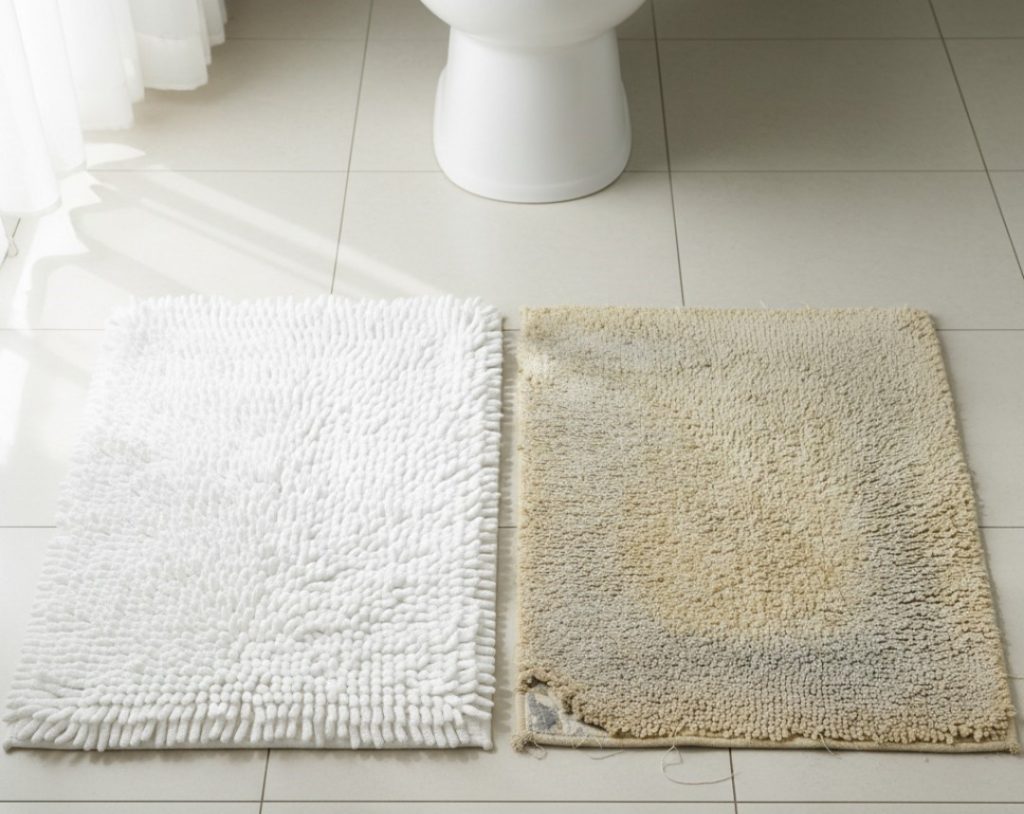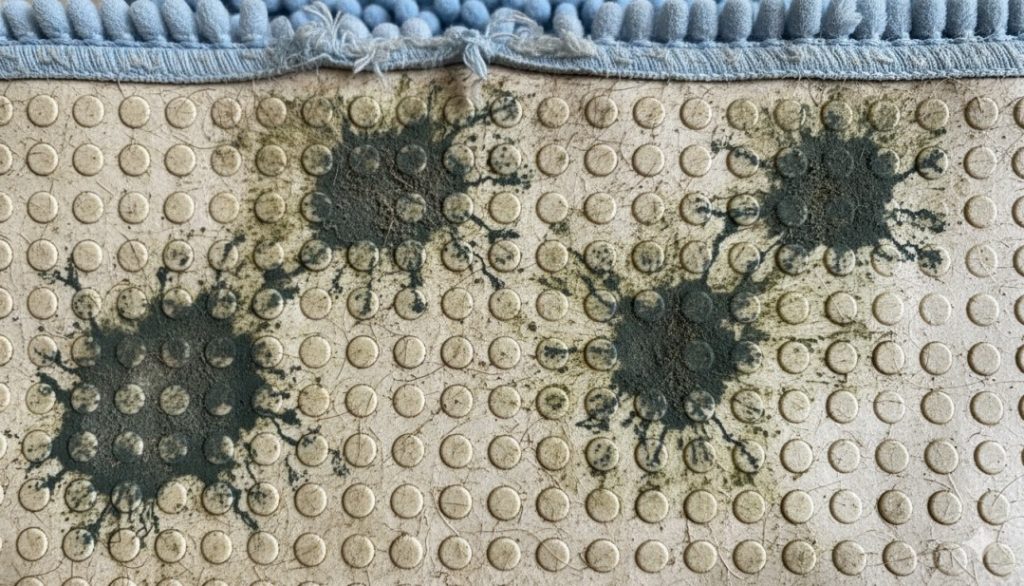I’ll be honest with you—I used to be one of those people who thought a bath mat could last forever. I mean, it’s just a mat, right? You wash it, it gets clean, and you keep using it. That mindset changed completely when I slipped getting out of the shower one morning because my “trusty” bath mat had lost its grip. That near-disaster made me realize I’d been ignoring some pretty obvious signs that it was time for a bath mat replacement.
If you’re wondering when to replace bathroom rugs or how long your current mat should actually last, you’re in the right place. I’ve learned the hard way what to look for, and I’m going to share the seven warning signs that mean it’s time to say goodbye to your old bath mat.

Why Bath Mat Replacement Actually Matters
Before we dive into the warning signs, let me tell you why this matters more than you might think. Your bath mat isn’t just about comfort or decoration. It’s a safety device that prevents slips and falls in one of the most dangerous rooms in your house. A worn-out bath mat can’t do its job properly, and that’s when accidents happen.
I learned this lesson during my own close call, and I don’t want anyone else to go through that heart-stopping moment of feeling your feet slide out from under you.
Sign #1: The Smell That Won’t Go Away
This was actually the first sign I noticed with my old mat, though I didn’t take it seriously enough at the time. You know that musty, mildew smell that hits you when you walk into the bathroom? If your bath mat is the source, that’s a major red flag.
I tried everything—hot water washes, vinegar soaks, baking soda treatments. Sometimes the smell would fade temporarily, but it always came back within a day or two. What I didn’t realize then is that once mildew gets deep into the mat’s fibers or rubber backing, it’s nearly impossible to eliminate completely. That persistent odor means bacteria and mold have set up permanent residence in your mat.
A moldy bath mat isn’t just unpleasant; it’s actually a health concern, especially if anyone in your home has allergies or respiratory issues. When you can’t eliminate the smell even after thorough washing, it’s time to replace the bath mat immediately.
Sign #2: Visible Mold or Mildew Spots
Speaking of mold, if you can actually see dark spots, discoloration, or fuzzy patches on your bath mat, you’ve moved past the warning stage. This is a clear sign that your mat has become a breeding ground for mold and bacteria.
I remember flipping my old mat over one day and being shocked by the black spots dotting the rubber backing. I had been so focused on keeping the top clean that I’d never thought to check underneath. Those spots weren’t coming out, no matter how much bleach or antifungal cleaner I used.

Here’s the thing about a moldy bath mat: once you see visible growth, the contamination goes much deeper than the surface. The spores have penetrated into the material, and no amount of cleaning will truly eliminate them. This is especially common if your mat stays damp for long periods or your bathroom doesn’t have great ventilation.
Sign #3: The Non-Slip Backing Is Cracking or Peeling
This was the warning sign directly connected to my almost-accident. The rubber or silicone backing that’s supposed to keep your mat firmly in place can deteriorate over time. When I finally examined my mat closely after that scary slip, I found that the backing had started cracking and peeling away in several spots.
A bath mat with compromised backing is honestly dangerous. It can slide unexpectedly when you step on it, especially if your feet are wet. I tested mine by giving it a gentle kick, and it practically glided across the tile floor. That’s when I realized I’d been risking a serious fall every single day.
The bath mat lifespan for the non-slip backing is typically shorter than the fabric itself, especially if you frequently put your mat in the dryer. The heat can accelerate the breakdown of rubber or silicone materials. If you notice any cracking, brittleness, or pieces flaking off, don’t wait—get a new mat right away.

Sign #4: It’s Become Thin, Flat, or Hard
Remember when your bath mat was thick, plush, and cushiony? If it’s now flat as a pancake and feels more like cardboard than fabric, that’s a clear sign it’s past its prime.
My old mat used to be wonderfully soft and absorbent. After a couple of years, though, it had compressed down so much that stepping on it felt like stepping on a damp towel lying flat on the floor. There was no cushioning left whatsoever, and it had lost most of its absorbency, too.
This happens naturally with use and repeated washing. The fibers break down, the batting inside compresses, and what was once a luxurious mat becomes an uncomfortable, ineffective one. When your mat no longer provides cushioning or quickly absorbs water, it’s not really serving its purpose anymore. That’s one of the clearest signs to replace the bath mat with something new.
Sign #5: Permanent Stains and Discoloration
I’m not talking about a little color fading here. I mean when your once-white mat has turned dingy gray or yellow, or when there are stains that won’t come out no matter what you do.
My previous bath mat developed these mysterious rust-colored stains that I could never explain or remove. I tried stain removers, oxygen bleach, even scrubbing by hand—nothing worked. Eventually, I accepted that those stains were permanent, and honestly, it made my whole bathroom look less clean, even though I was keeping everything else spotless.
Beyond aesthetics, permanent discoloration often indicates that the material has degraded or that substances have penetrated too deeply into the fibers. It’s a visual reminder that your mat has been through a lot and probably isn’t as hygienic as it once was, even if you’re washing it regularly.
Sign #6: Frayed Edges or Unraveling Material
The edges of your bath mat take a lot of abuse. They get caught on door swings, snagged by vacuum cleaners, and gradually wear down from foot traffic. When I noticed my mat’s edges starting to fray and unravel, I initially thought it was just cosmetic.
But those frayed edges quickly became tripping hazards. Loose threads caught on my toes several times, and parts of the binding completely came apart, creating little fabric loops that stuck up from the floor. It looked sloppy, sure, but more importantly, it became another safety issue.
When the structural integrity of your mat starts breaking down—whether that’s frayed edges, holes developing, or seams coming apart—it’s definitely time for when to replace bathroom rugs to become more than just a consideration.
Sign #7: You Can’t Remember When You Bought It
Here’s a simple test: can you remember when you purchased your current bath mat? If you’re drawing a blank or thinking “it’s been a while,” that’s probably sign enough that it’s time for an upgrade.

Most experts recommend replacing bath mats every one to two years with regular use. If you have a larger household with more foot traffic and bathroom use, you might need to replace them even more frequently. I’ve found that setting a reminder on my phone or making bath mat replacement part of my annual spring cleaning routine helps me stay on top of it.
Even if your mat doesn’t show obvious wear, microscopic breakdown happens over time. The materials deteriorate, bacteria accumulates despite washing, and the mat simply becomes less effective and less sanitary.
How to Make Your New Bath Mat Last Longer
After going through the hassle of replacing my worn out bath mat, I became committed to making the next one last as long as possible while still maintaining hygiene and safety. Here’s what I’ve learned works:
Wash it regularly. I aim for once a week or every two weeks, depending on how much use it gets. This prevents buildup of bacteria, mildew, and soap residue that can accelerate deterioration.
Hang it to dry. This was a game-changer for me. Instead of leaving my mat on the floor all day, I now hang it over the shower rod or towel bar after each use. This allows air circulation and prevents that constant dampness that breeds mold. My current mat has stayed fresh-smelling much longer than my previous ones.
Air-dry instead of machine drying when possible. The heat from the dryer is tough on rubber backing and can break down the fibers faster. I only use the dryer on low heat when absolutely necessary.
Keep your bathroom well-ventilated. Running the exhaust fan during and after showers, or cracking a window, makes a huge difference in preventing moisture buildup that damages bath mats.
Rotate between two mats. If you have the space and budget, having two mats that you alternate between gives each one time to fully dry out between uses, extending their lifespan considerably.
The Bottom Line on Bath Mat Replacement
Looking back, I probably ignored those warning signs for way too long with my old mat. Between the smell, the loss of grip, and the general deterioration, I should have replaced it months before that near-slip incident forced my hand.
Now I’m much more vigilant about checking for these seven warning signs. Yes, replacing your bath mat means spending money, but a good quality mat typically costs between $15 and $40—a small price to pay for safety, hygiene, and peace of mind.
If you’re reading this and recognizing any of these signs in your own bathroom, take it as your wake-up call. Don’t wait until you have a scary moment like I did. A fresh, functional bath mat makes your bathroom safer, cleaner, and honestly just more pleasant to use. Your feet (and your family) will thank you.
Trust me, when you step out of the shower onto a new, plush, properly grippy bath mat for the first time in years, you’ll wonder why you waited so long to make the change. It’s one of those small home updates that makes a bigger difference than you’d expect.
Leave a Reply